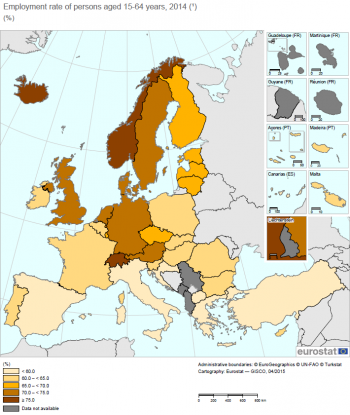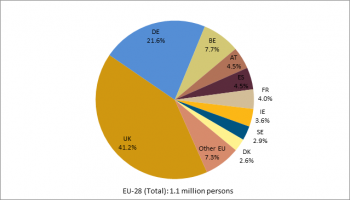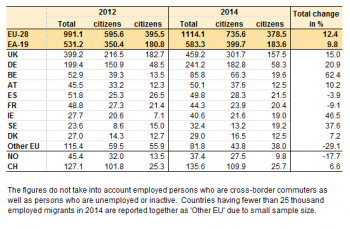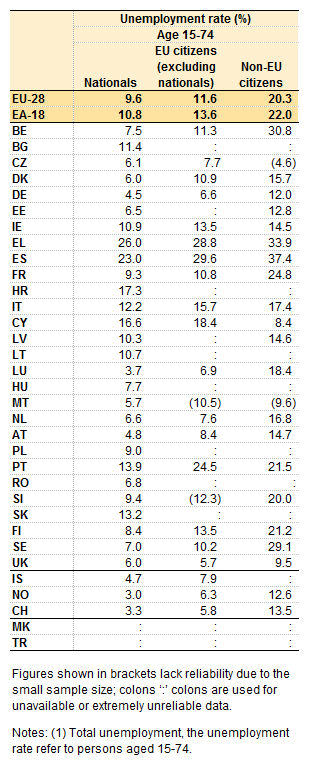Archive:Statistics on employment characteristics of households
- Data extracted in April 2015. Most recent data: Further Eurostat information, Main tables and Database.
European Union Labour force survey - Annual results 2014
Author: Martin Teichgraber (Eurostat, Labour market)
This article presents the main results for 2014 of the EU Labour force survey (LFS) for the European Union (EU) as a whole (EU-28) and for all Member States, as well as two candidate countries and three EFTA countries. Indicators presented in this publication are: employment rates, part-time employment, number of employed people, hours usually worked, employees with limited duration contracts. , number of self-employed persons, self-employment as a proportion of total employment, unemployment rate, long-term unemployment, youth unemployment ratio and number of persons not in the labour force.
<thumb src="Dashboard - new image - 3.png">
Dashboard 1: Labour status of persons aged 15 years or older, EU-28, 2014 - Source: Eurostat
(lfsa_ergan)
Click the image for an interactive view of the data

Source: Eurostat (lfsa_etpga)
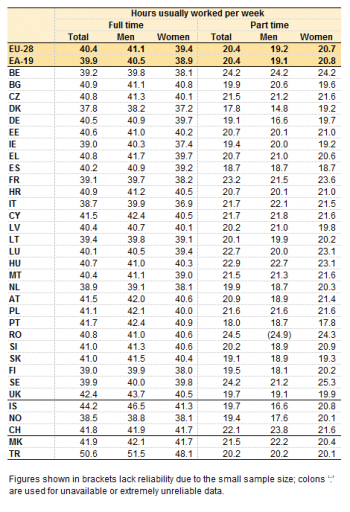
Source: Eurostat (lfsa_ewhuis)
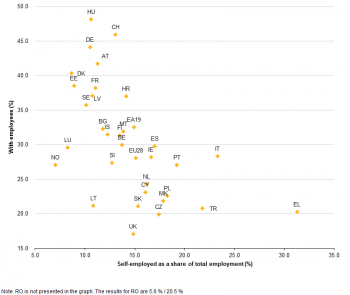
Source: Eurostat (lfsa_egaps)
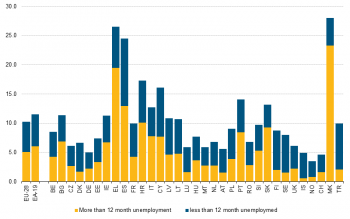
Source: Eurostat Eurostat (lfsa_urgan) (lfsa_upgan)
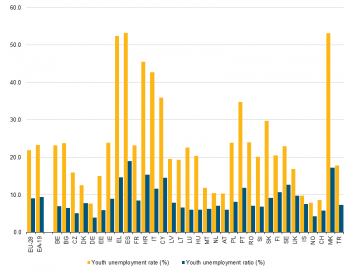
Source: Eurostat Eurostat (lfsa_urgan) (lfsi_act_a)
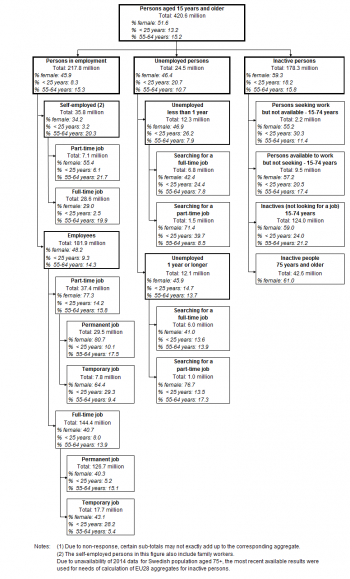
Source: Eurostat (lfsa_urgan)
Main statistical findings
In 2014, the state of the EU labour market was still determined by the economic crisis, as in previous years, but showed also some signs of recovery. The key EU figures did improve: the unemployment stopped the negative trend of the last years and the employment showed also first signs of a recovery. In contrast to the positive developments did the divergence of the national labour market developments between Member States in 2014 not significantly diminsh.
The 2014 EU employment rate[1] for persons of working age (15-64) rose to 64.9%, an increase of +0.8 percentage points compared to 2013. For the euro area (EA-19) it increased slightly to 63.9 % (+0.4 pps).
The employment rate for the population aged 15-64 exceeded 70 % in six EU Member States (see Map 1). The highest rates were recorded by Sweden (74.9 %), the Netherlands (73.9 %) and Germany (73.8 %). The employment rates for the EFTA countries were above 75 %, with Iceland and Switzerland recording 81.7 % and 79.8 % respectively in 2014.
Four Member States did not reach 60 %; this was an improvement compared with 2013 when 7 Member States did not reach 60 %. The lowest employment rates were observed in Greece (49.4 %), Croatia (54.6 %), Italy (55.7 %) and Spain (56.0 %).
Compared with 2013, the employment rate increased by 2.0 percentage points (pps) or more in Hungary (+3.7 pps), Croatia (+2.1 pps), Lithuania (+2.0 pps) and Portugal (+2.0 pps). On the other hand, the employment rate fell only slightly in the Netherlands (-0.4 pps), Austria (-0.3 pps) and Finland (-0.2 pps).
The employment rate for the narrower age group of 20-64 years old is used as one of the headline indicators in the Europe 2020 strategy. The EU employment rate for persons aged 20-64 rose in 2014 by 0.8 pps to 69.2 %, still well below the target rate of 75 % (Europe 2020 strategy)[2] by 2020.
In addition the general trend of an increasing employment rate of older persons continued. The EU employment rate for those aged 55-64 rose to 51.8 % (+1.7 pps compared with 2013). Sweden recorded a very high employment rate in this age group (74.0 %), followed by Germany (65.6 %) and Estonia (64.0 %). The countries with the lowest employment rates for persons aged 55-64 were Greece (34.0 %), Slovenia (35.4 %) and Croatia (36.3 %) (see lfsa_ergan).
Labour force in the EU
The labour force in the EU (i.e. the total of employed and unemployed persons) reached 242.3 million persons in 2014, an increase of 0.8 million on 2013.
The number of persons in employment rose by around 2.3 million to 217.8 million in 2014; this development is due to an increase in the number of employed men (+1.1 million) and in the number of employed women (+1.2 million). In 2014, 45.9 % of the employed were women. The total number of employed persons comprised 35.8 million self-employed (including family workers), and 181.9 million employees.
Employees
In 2014 employees accounted for 83.5 % of total EU employment. The proportion of employees was above 90 % in Denmark and Luxembourg (both 91.1 %) and Estonia (90.9%). The figure was below 70 % in both Greece (64.0 %) and Romania (67.9 %). In the EU, 48 % of employees were women. There are sizeable differences between Member States in the proportions of employees working part-time and employees with contracts of limited duration.
Part-time employment was stable from 2013 to 2014. Part-time employment among employees stood at 20.6 % in the EU. Some three out of four employees working part-time in the EU were women (77.3 %).
In the EU countries, the share of employees working part-time was highest in the Netherlands (52.4 % of employees), followed by Germany (28.3 %), Austria (27.7 %), Denmark (26.3%) and the United Kingdom and Sweden (both 26.2 %). The lowest shares were recorded in Romania (0.7 %), Bulgaria (2.1 %), Croatia (3.0 %), Slovakia (5.7 %) and Latvia (5.9 %). Two EFTA countries, Switzerland (37.4 %) and Norway (26.5 %), also had a relatively large share of part-time employees (see Figure 1).
Employees in full-time jobs usually worked 40.4 hours per week in 2014. The United Kingdom (42.4 hours), and Portugal (41.7), Austria and Cyprus (both 41.5) had the longest weekly working hours, while employees usually worked less than 39.0 hours per week in Denmark (37.8), Italy (38.7) and the Netherlands (38.9). Part-time employees usually worked 20.4 hours per week in the EU in 2014. They worked longest in Romania (24.5), Sweden and Belgium (both 24.2) and shortest in Denmark (17.8) and Portugal (18.0).
In 2014, the gender pattern of full-time and part-time employees differed: while male full-time employees usually worked longer hours than female employees in the EU (41.1 to 39.4 hours per week) and in each Member State, it is the opposite for part-time workers in many countries but not all (see Table 1).
Employees with limited duration contracts accounted for 14.0 % of all employees in the EU. Compared with 2013, the proportion did not change significantly (+0.3 pps). The highest proportions were recorded in Poland (28.4 %), Spain (24.0 %), the Netherlands (21.7 %) and Portugal (21.4 %), while it was below 5 % in Romania (1.5 %), Lithuania (2.8 %), Estonia (3.2 %) and Latvia (3.3 %) (see Figure 1).
Self-employed
In 2014 self-employed persons (including family workers) accounted for 16.4 % of total EU employment. Of the 35.8 million self-employed persons in the EU, 28.6 million worked full-time and 7.1 million part-time. The proportion of women among the self-employed was much lower (34.2 %) than among employees, but was higher among part-time self-employed persons (55.4 %).
The proportion of self-employed persons (excluding family workers) varied significantly between countries. It was above 20 % in Greece (31.3 %) and Italy (23.3 %) and Portugal (20.9 %), and below 10 % in Luxembourg (8.3 %), Denmark (8.7 %) and Estonia (8.9 %). Staff was employed by 28.1 % of self-employed persons in the EU. The proportion of self-employed with staff among the self-employed was higher than 40 % in Hungary (48.1 %), Germany (44.1 %), Austria (41.7 %) and Denmark (40.3 %), and below 20 % in Romania (5.6 %), the United Kingdom (17.1 %) and the Czech Republic (19.9 %) (see Figure 2).
Foreign workers in the EU
In 2014 there were 15.2 million persons living and working in an EU Member State of which they were not a citizen, accounting for 7.0 % of total EU employment. 7.3 million of them were citizens from another EU Member State and 7.9 million were non-EU citizens. The highest proportions of foreign workers among all employed persons in the EU were recorded in Luxembourg (50.5 %) and Cyprus (19.2 %). Among the EFTA countries, Switzerland had a relatively high proportion of foreign workers (24.6 %) (see lfsa_egan).
In the EU as a whole, the employment rate of citizens from another EU Member State [3] was significantly higher (69.2 %) than that for non-EU citizens (53.4 %) and even for nationals (64.9 %). In 17 Member States the employment rate for foreign citizens from another Member State was higher than the rate for nationals. It was highest in Slovakia (80.3 %), Latvia [4] (78.9 %), the United Kingdom (77.9 %) and Estonia (77.5 %). The employment rate for non-EU citizens was above 70 % in the Czech Republic, Cyprus and Latvia. (see lfsa_ergan).
In the last two years, more than one million persons took up residence and worked in an EU Member State other than their country of citizenship. Of these, 41.2 % took up residence and worked in the United Kingdom, 21.6 % in Germany, 7.7 % in Belgium and 4.5 % in Austria respectively Spain (see Figure 3).
736 000 foreign workers who migrated to or within EU countries in the last two years were citizens from another EU Member State and some 379 000 were non-EU citizens. Compared with 2012, the total number of non-national employed persons who had recently moved to an EU country other than their country of citizenship increased by 12.4 %. The growth is due to increased mobility of EU citizens; the mobility of non-EU citizens has however declined. Furthermore the trends across Member States were very different (see Table 2).
Most of these foreign workers did not move alone within or into the EU. In 2014, around 1.8 million family members [5] took up residence with them.
Unemployed
Unemployment in the EU fell to 24.5 million persons in 2014, 1.5 million less than in 2013. Women accounted for 46.4 % of the unemployed persons. The number of unemployed women fell by 0.6 million to 11.4 million, and by 0.9 million to 13.1 million for men compared with 2013 (see lfsa_ugan).
The EU unemployment rate was 10.2 % in 2014, a decrease of 0.6 pps on 2013. In 2014, the rate ranged from 5.0 % in Germany, 5.6 % in Austria, 5.9 % in Luxembourg, 6.1 % both in the Czech Republic and the United Kingdom to 26.5 % in Greece, 24.5 % in Spain, 17.3 % in Croatia and 16.1 % in Cyprus (see Figure 4).
The share of long-term unemployment has steadily increased over the last couple of years. While 49.5 % of unemployed persons in the EU had been out of work for 12 months or longer in 2014, the figure was 33.2 % in 2009. Long-term unemployed accounted for over half of total unemployment in nine Member States — Greece (73.5 %), Slovakia (70.2 %), Italy (61.4 %), Bulgaria (60.4 %) — while it was below 25 % in Sweden (18.9 %) and Finland (22.4 %).
In 2014 long-term unemployment increased significantly in Cyprus (+ 9.4 pps) and Greece (+ 6.4 pps), compared with 2013.
The main indicator of youth unemployment is the youth unemployment rate for the 15-24 age group. It uses the same standard definition as the unemployment rate for the population aged 15-74 which is defined as the number of unemployed divided by the labour force (employed and unemployed persons). In 2014, the youth unemployment rate in the EU was 21.9 %. Member States had very different youth unemployment rates — it was above 50 % in Spain (53.2 %), Greece (52.4 %), while Germany (7.7 %), Austria (10.3 %), the Netherlands (10.5 %) and three EFTA countries, Norway (7.9 %), Switzerland (8.6 %) and Iceland (9.8 %), recorded rates below or around 10 % (see Figure 5). The youth unemployment ratio is another indicator of the incidence of unemployment among young people. It is defined as the number of unemployed aged 15-24 divided by the population of that age. This is an important indicator, in particular for young people, as not every young person has entered the labour market yet.
In 2014 the youth unemployment ratio was 9.1 %, or approximately half the youth unemployment rate. The highest youth unemployment ratios were recorded in Spain (19.0 %), Croatia (15.3 %), Greece (14.7 %) and Cyprus (14.5 %). The lowest ratios were recorded in Germany, the Czech Republic, Estonia, Luxembourg, Austria and Hungary where they were 6 % or lower. Italy has one of the highest youth unemployment rates (42.7 %), but an unemployment ratio (11.6 %) lower than Sweden (12.7 %).
These results show that the transition from education to the labour market is not a simple switch of status. For a more detailed explanation, please see the articles 'Participation of young people in education and the labour market' and 'Youth unemployment'.
The unemployment rate in the EU is generally higher for foreign citizens than for nationals of the country in question. In 2014, the EU unemployment rate for citizens from another EU Member State was 11.6 %, while for foreign citizens from outside the EU the rate was almost twice as high (20.3 %). The highest unemployment rates for foreign non-EU citizens were observed in Spain (37.4 %), Greece (33.9 %) and Belgium (30.8 %). Unemployment rates of around 10 % or lower were recorded in the Czech Republic, Cyprus, the United Kingdom and Malta (see Table 3).
Population not in the labour force
In 2014, 178.3 million persons living in the EU were not in the labour force, i.e. neither employed nor unemployed. Of these, 59.3 % were women, 18.2 % were 24 years old or younger and 23.9 % were older than 75. Some of the persons aged 15-74 not in the labour force share some characteristics with the unemployed, even if they do not fulfil all the criteria of the unemployment definition of the International Labour Organisation (ILO). In 2014, 2.2 million persons aged 15-74 were seeking work but were not immediately available to work and 9.5 million were available for work but were not seeking it. They were 1.2 % and 5.5 % respectively of persons aged 15-74 not in the labour force. For a more detailed analysis on the types of joblessness not covered by the ILO definition, please see the article 'underemployment and potential additional labour force statistics'.
Synoptic overview: population by labour status
The synoptic overview (see Figure 6) summarises key results on the labour status of persons aged 15 years and older in the EU-28. The information comprises the following categories: employed, unemployed and persons not in the labour force.
The results include information on self-employed persons, employees, persons in part-time and full-time jobs and persons in permanent and temporary jobs. The results also contain information on short- and long-term unemployment and the number of persons seeking a full-time or part-time job.
Figure 6 reports absolute numbers and the specific proportion of females, as well as of young and elderly persons.
Data sources and availability
Source: the European Union Labour Force Survey (EU-LFS) is a large sample, quarterly survey providing results for the population in private households in the EU, EFTA and the candidate countries. Conscripts in military or community service are not included in the results.
Reference period: Yearly results are obtained as averages of the four quarters in the year.
Coverage: The data for France cover the metropolitan territory (excluding overseas regions) Country codes: Belgium (BE), Bulgaria (BG), the Czech Republic (CZ), Denmark (DK), Germany (DE), Estonia (EE), Ireland (IE), Greece (EL), Spain (ES), France (FR), Croatia (HR), Italy (IT), Cyprus (CY), Latvia (LV), Lithuania (LT), Luxembourg (LU), Hungary (HU), Malta (MT), the Netherlands (NL), Austria (AT), Poland (PL), Portugal (PT), Romania (RO), Slovenia (SI), Slovakia (SK), Finland (FI), Sweden (SE), the United Kingdom (UK), Iceland (IS), Norway (NO), Switzerland (CH), the former Yugoslav Republic of Macedonia (MK), Turkey (TR). The abbreviation MK used for the former Yugoslav Republic of Macedonia is a provisional code which does not prejudice in any way the definitive nomenclature for this country, which will be agreed following the conclusion of negotiations currently taking place on this subject at the United Nations.
European aggregates: EU refers to the sum of EU-28 Member States and EA to the sum of the 19 euro area Member States. If data are unavailable for a country, the calculation of the corresponding aggregates takes into account the data for the same country for the most recent period available. Such cases are indicated.
Definitions: The concepts and definitions used in the survey follow the guidelines of the International Labour Organisation. Employment covers persons aged 15 years and over (16 and over in Spain, Italy and the United Kingdom, 15-74 years in Estonia, Latvia, Hungary, Finland, Sweden, Norway and Denmark, and 16-74 years in Iceland), living in private households, who during the reference week performed work, even for just one hour, for pay, profit or family gain, or were not at work but had a job or business from which they were temporarily absent, for example because of illness, holidays, industrial dispute or education and training.
The LFS employment concept differs from national accounts domestic employment, as the latter sets no limit on age or type of household, and also includes the non-resident population contributing to GDP and conscripts in military or community service.
Unemployment covers persons aged 15-74 (16-74 in Italy, Spain, the United Kingdom and Iceland) who were not employed during the reference week, were currently available for work and had either been actively seeking work in the past four weeks or had already found a job starting within the next three months.
Long-term unemployment covers persons unemployed for one year or more. Youth unemployment is unemployment of persons aged 15 to 24. Citizenship is defined according to the national legislation of each country.
Definitions of indicators reported in this publication are available on the EU-LFS Statistics Explained website: EU Labour Force Survey (Statistics Explained)
Context
The EU-LFS is the largest European household sample survey providing quarterly and annual results on labour participation of people aged 15 and over as well as on persons outside the labour force. It covers residents in private households. The EU-LFS is an important source of information about the situation and trends in the EU labour market.
Each quarter around 1.8 million interviews are conducted throughout the participating countries to obtain statistical information for some 100 variables. Due to the diversity of information and the large sample size the EU-LFS is also an important source for other European statistics like Education statistics or Regional statistics.
See also
Further Eurostat information
Publications
- Labour market statistics - Pocketbook - 2011 edition
- European Union Labour force survey - selection of electronic articles (Statistics Explained)
Main tables
Database
Dedicated section
Methodology / Metadata
Notes
- ↑ Employment rates represent employed persons (LFS concept, see Data sources and availability) as a percentage of the population in the same age group.
- ↑ The European Strategy for a smart, sustainable and inclusive growth (Europe 2020) aims to raise to 75 % the employment rate for men and women aged 20-64 for the EU as a whole. This headline target is translated into specific targets for each Member State (see Conclusions of the European Council — 17 June 2010). For detailed data at EU and at national level for the 20-64 age group, see the dedicated section on Europe 2020 indicators.
- ↑ The employment rate of foreign citizens is calculated as the proportion of foreign citizens aged 15-64 of the total number of foreigners aged 15-64 residing in the country.
- ↑ The figure for Latvia lack reliability due to small sample size.
- ↑ Family members include spouses and children in the same household with less than two years residence in an EU Member State other than their country of citizenship or with a non-EU citizenship.
